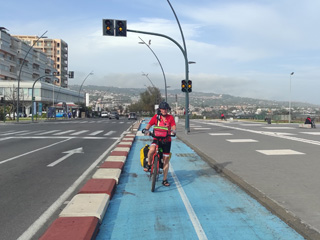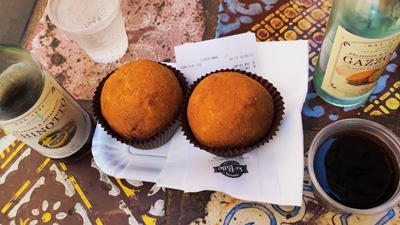
Palermo – Zingaro Nature Reserve – Trapani – Marsala – Selinunte – Sciacca – Agrigento – Ragusa – Modica – Pozzallo – Noto – Siracusa – Catania – Bronte – Taormina – Catania (Italy)
(866km cycled)
Considering that the Greeks, Phoenicians, Romans, Byzantines, Arabs, Normans, German, French, British and Spanish had all been to Sicily, we decided that it was high time for Gone Bike About to check it out!
By the time we arrived in Palermo, we had a 36-hour train and ferry combo behind us in an attempt to limit our air travel. However, judging by the fumes billowing out of the ferry for the 21-hour journey, we doubt that it enhanced our carbon footprint any more than a three-hour flight would have done. Perhaps fifteen hours on a multitude of trains would have done more for our ecological consciences.


Palermo did not disappoint. In fact, if we ever wanted to learn Italian, this city would be a place where we could do it. Magnificent architectural treasures from the various eras make it certainly one of those places to see before you die!


Like the whole island, Palermo has a history of subsequent rulers, starting with Phoenician colonies in 900 BC, and Greek colonies a couple of centuries later. Then Carthage and Rome fought bitterly over this appealing breadbasket; Vandal, Byzantine, and Arab rule followed before Norman mercenaries decided to fight for themselves and settle in their newly founded kingdom. Then Swabian and French kings came and went before a branch of the house of Aragon took over and stayed in power (more or less) until Garibaldi captured Sicily for modern Italy in 1860. The Brits even had a 15-year stint administering the island in the early 19th century.


And that’s the history in a nutshell. While it may be a little dizzying, the upside is that it has left the visitor a wealth of spectacular monuments to admire. So, if the history doesn’t daze you, the array of monuments certainly will!

Zingaro Nature Reserve is protected as the last stretch of pristine Sicilian coast, and it offers wonderful hikes with spectacular views. On the way there, we encountered our first savage downpour that turned roads into rivers, but for our day hiking the reserve was graced with glorious sunshine.



Darina’s fascination with tiny houses and abandoned places brought us to Grotta Mangiapane, a former agricultural village built into a cave entrance near the modern town of Cornino. Adventure number 1! Komoot’s idea of getting there was a 2km shortcut through a marble quarry wasteland-cum-river which left us no option than to lug our bikes and wonder if a 10km detour wouldn’t have been quicker. The proposed way out was a recently constructed bicycle path along the coast, definitely not built with cyclists’ tyres in mind!



The heavens opened in Trapani as Darina invested in a pair of luminous yellow socks to brighten up an otherwise miserable afternoon. The socks would have been the highlight of the day if we hadn’t found a flamboyance of photogenic flamingoes wading through the salt flats on the outskirts of town.



Optically energized, we made it to the beautiful town of Marsala, where we found a cosy room and a wonderful steakhouse with local specialities. Some things seldom change!



It was a beautiful ride through rolling hills, vineyards, olive groves and citrus plantations to the ruins of Selinunte, a Greek colony of 100,000 inhabitants dating back to 700 BC. A reconstructed temple is the main attraction, but there would be enough material among the rubble to build another few.





From Sciacca we were on the busy main road (SS115) for about 20km before turning inland on Komoot’s suggestion. While the quiet country (often dirt) roads were a welcome break, they were all graced with numerous no-bicycle signs, which didn’t seem to make any sense at all. Kurt’s guess is that they came cheap if you ordered a few dozen! We even entered Agrigento on such a road for lack of an alternative, as did several local cyclists.



Agrigento was a Greek colony twice the size of Selinunte, established in 500 BC. Five fascinating temples remain in the archaeological park and there’s a lively town at the top of the hill to explore after a day templing around.


Now to the saddest stretch of road. From Agrigento to Comiso, short before Ragusa, the road is one long horrendous dumping ground. Without a doubt, Gela wins the Gone Bike About Dented Globe Award for garbage. Actually, this 100km is so terribly spoiled, we both contemplated something we have never entertained in all our years of travel, i.e., going home or somewhere else. We tried to explain it, understand it, even excuse it, and in the end we decided to soldier on and hope for the best. Don’t despair, there is a lot of beauty just a scroll away.



Ragusa, Modica, Noto and surrounding towns were all flattened by a powerful earthquake in 1693. Luckily, the Spanish, who were in power at the time, invested their extra cash into a fantastic rebuilding project leaving awesome baroque gems that are an absolute sight to behold. These towns have also got their garbage in order with colour-coded recycling bins all round town.






You couldn’t be blamed for mistaking pictures from this corner of Sicily with Darina’s Emerald Isle. Stone walls, misty views and waterlogged fields are the order of the day, and there are even a few dolmens!


Adventure number 2 was not far away. It came in the form of fierce headwind gales and torrential rain thanks to Storm Gloria. As we left Noto for Siracusa, the locals all warned us of the “tempo bruto” (brutal weather) forecast for the rest of the week. Schools had been closed and the east coast was preparing for the worst.


We encountered numerous floods en route, but it wasn’t until we arrived in Siracusa and as videos of Catania’s devastation began to emerge that we realised the severity of the situation. Cars floated down the main drag and the city plazas had turned into lakes. Storm Gloria was now recategorized and Medicane Apollo (Mediterranean hurricane) was brewing offshore.



Non-essential shops, museums and parks were shut until further notice; trains, busses and ferries were no longer running. Kurt got busy rerouting inland, but roads were closing one after the other and it was clear, there was no way out of Siracusa. The beautiful ground-floor apartment we had rented was a concern, but luckily there was more howling wind than driving rain in store for us. We were stuck for five days.



Now, if you do get stuck somewhere in Sicily, it would be hard to beat Siracusa. The mightiest of all Greek colonies, with half a million inhabitants in 300 BC, today it’s a pleasant town with a great natural harbour and a medieval old town incorporating ancient walls and columns.


Probably one of the town’s most famous Greek residents was Archimedes, the scientist who supposedly had an aha! moment in the bath before running naked through town shouting Eureka! Eureka! Well, there is certainly no shortage of water in this neck of the woods and he wouldn’t have even needed a bath while we were there to figure out the principle of buoyancy! Anyway, his tomb was cruising for a serious flooding as we looked on… so keep your ears to the ground for the Principle of Archimedes 2.0!


There were some waterlogged stretches on the road into Catania, which was still under the weather a week later. Catania, rebuilt with black basalt from nearby Mt Etna after the famous earthquake some 300 years ago, looks very drab on grey overcast days. Unfortunately, garbage was a recurring theme in the city and surrounding area.



While the amphitheatre, churches and castle are the main attractions, what Kurt will never forget is the huge horse T-bone steak he gorged on in one of the local restaurants.


We had just enough time left to ride around Mt Etna and have a good look at Taormina. Climbing up from Catania, it seemed that half the city’s cars were using the same shortcut through the narrow streets and country roads. So, we decided to take the main road meant for them. That gave us a hard shoulder and less rubbish. At least here the volcano erupts and buries the garbage every thousand years or so.



The day down to Taormina was our best on the whole trip. Mt Etna was out in all its glory and as we descended to the coast, vineyards, citrus plantations, medieval towns and castles were framed with fantastic mountain views before a very steep incline to Taormina, an utter treasure of a town.



Cruising on quiet roads back to Catania was pleasant. Mt Etna’s recent activity had spouted out tonnes of ash, which was still visible on the backroads and in piles outside towns. It was this ash that had filled the drains causing the serious flooding in Catania during the rainstorm.


Catania in sunshine is like a totally different city. The black stone takes on an elegant, polished appearance and the buildings look stately rather than dreary. With the fishermen back out at sea, we got to experience the local fish market and even had time for a guided tour of Teatro Bellini (not Greek!).



So, what is it about Sicily that attracted so many civilisations over the centuries? Well, its strategic location, mild climate, fertile soil and water sources were certainly additional motives besides power itself. The architectural jewels these empires left behind are undoubtedly part of what attracts tourists today. Add very friendly folk, excellent food, wine and craft beer, beautiful scenery and (usually) mild weather in the shoulder seasons and you have a recipe for success.

















Sicily has it all, but unless the garbage problem is attended to real soon, this Mediterranean paradise will roller-coast to disaster.




